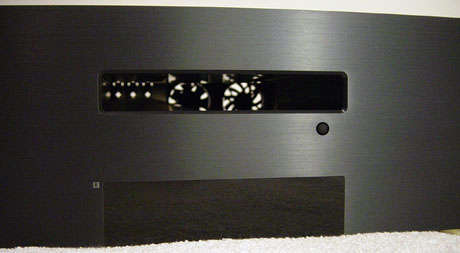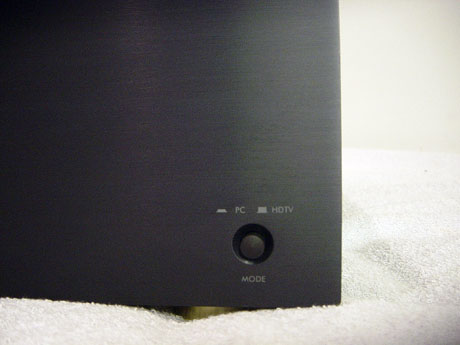December 2004 HTPC Case Roundup
by Purav Sanghani on December 27, 2004 2:00 AM EST- Posted in
- Cases/Cooling/PSUs
Ahanix D.Vine 5
We had our first look at Ahanix in the HTPC market with their D.Vine 4 case in our introduction to HTPC cases back in October. We only looked at it briefly as a sort of feature check on HTPC cases as we talked about what to look for in HTPC cases in general. Then, about a month ago, we compared another Ahanix model to the new Intel BTX form factor to gauge thermal and sound conditions. Again, we only took a brief look at the case's features, since the review was to compare BTX to the ATX form factor. We now have a chance to look a bit more in-depth into the last Ahanix model, the D.Vine 5 HTPC chassis by Ahanix and see its full potential as an HTPC case.External Design
The D.Vine 5 looks a bit like the D.Vine 4 with its brushed aluminum front bezel. It stands slightly shorter than its predecessor at about 5.7" as opposed to the D.Vine 4's 7" height. At the left, we see the "D.Vine Home Theater PC" logo printed in a contrasting color, which keeps the look of the bezel pleasing to the eyes. At the bottom left corner of the bezel is where the Power and Reset buttons as well as the Power LED reside. The Power button is noticeably larger than the reset button, which helps users distinguish between the two when in total darkness. Otherwise, each button is clearly labeled. Also, both buttons are easy to press and give off a clicking sound to assure the user that they have been pressed successfully.
The middle section of the bezel is occupied by a single optical drive slot and an integrated LCD display. The D.Vine 5 comes with an aluminum optical drive bezel replacement, which matches the case's bezel and will replace the optical drive's factory tray bezel. Under the drive tray slot to the right is a small, round drive eject button, which is labeled "OPEN". The integrated Vacuum Florescent Display is the same 2x16 display with a parallel port interface used in the D.Vine 4. It also features an IR receiver, which can be used with almost any PC IR remote with Windows Media Center Edition.

At the bottom right corner of the bezel, we notice a two-position button that is labeled "MODE". The down position enables "PC" mode while the up position enables "HDTV" mode. This button would most likely control the once optional EiOS HDTV receiver, which was planned to be bundled with the D.Vine 5. EIOS has gone out of business since then and is no longer in production. Ahanix has also removed the mounts for the EiOS HDTV receiver and they will not be found on 90% of the units on the market today.











34 Comments
View All Comments
Pandamonium - Monday, December 27, 2004 - link
I concur w/ #12. There seems to be incredible bias towards Silverstone here. Despite my research in the world of HTPCs, I had not even heard of NMedia. This article may have introduced me to my future HTPC chassis - my current choice is with the Ahanix X235 (Formerly D.Vine 5)Excellent job on the thermal maps though. This was the first time I've seen thermal readings taken at every square inch and then visually reported in such a manner. If more reviewers pick up on this trend for case reviews, I'd be extremely pleased.
SunTzuTech - Monday, December 27, 2004 - link
Agree with #12. The review seems to be slanted to the SilverStone, despite it's cost and obviously audible intrusion. Perhaps if there had been some more detail into the IR remote that's talked about in the conclusion, comparing and contrasting the other components, I'd buy the review. However, in the end, it doesn't pass the sniff test.If you don't like the NMedia because it only supports mATX, say so. But the fact that it's quieter than the rest, should be the first consideration for an HTPC case.
#11 - I found a LianLi PC9400 and 320W mATX PS in about 3 minutes of searching on the internet. Nice case, but the IR remote is something you'd have to add.
hoppa - Monday, December 27, 2004 - link
also agree w/ 4 and 5. what is with anandtech recently and giving so much praise for big, loud, expensive cases? the nMedia is about half the price, half the size, has half the noise output... for some reason, you didn't give it an X for 'thermal' in that chart (i assume the X means good?), even though its highest temperature was the exact same as that of the silverstone, and overall temperature seemed to be quite the same. and how about these quotes..:from thermal page:
"It is evident that while the NMediaPC's HTPC 100 case had only a single 60mm exhaust, it performed almost as well as the LC10/M and the Cavalier 2, and better than the D.Vine 5 in our thermal benchmarks due to its smaller size as well as the numerous ventilated areas on the shell. On average, the ambient air temperatures per square inch varied by only fractions of a degree."
from conclusion:
"NMediaPC's HTPC 100 did not perform as well in our thermal benchmarks as the LC10/M or the Cavalier 2"
that kind of editorial slant in the conclusion is completely unfair. for someone that reads only the conclusion (which im sure many do), it sounds as though there is actually some real difference in the thermal performance, even though you say originally on the page that performance only varies by fractions of a degree.
so what we have here is a much louder, much more expensive, bigger case than the nMedia, with equal thermal performance and included features, and you give this the gold?! plus, the thing is ugly.
you may give accurate numbers, but lately your conclusions are making me wonder.
gonzo2k - Monday, December 27, 2004 - link
Full size motherboards MUST fit in a HTPC case to be considered practical for my needs.I have an extemely rare Lian-Li PC9400 that gives these three a run for the money.It took me weeks to locate a 300+ watt psu for it (mATX). Finally scored a 320 watt!
Bought the case used (like new) on AT for $150 (came with an FSP-200 psu... the replacement 320W psu was another $35/shipped. Added Vantec Stealth 60mm fans to replace the stock ones & all is well. 2 HDDs, 2 optical drives and a floppy bay for a 7-in-1 media reader make this case a keeper.
JKing76 - Monday, December 27, 2004 - link
I'm failing to see how the rollover temperature data images back up the claim that the Silverstone has better thermal management than the Nmedia.CrystalBay - Monday, December 27, 2004 - link
Nice review, I also like the NMedia for the looks, and quietness. Seems like some manufacturer could find a spot for a low noise, low rpm 120mm fan.mrdudesir - Monday, December 27, 2004 - link
I'd agree with #4 and 5, the NmediaPC seems like a much better buy than the silverstone. Of course astethics depend on the person, but it is a 100 dollars cheaper, and produces less than half the noise of the silverstone. Especially in an htpc environment, 51db is unacceptable.joeld - Monday, December 27, 2004 - link
Why disable the fan on the power supply for the audio tests? Think about it - the power supply comes with each of the chassis's, so why not test the sound "out of the box"? I've got a shuttle XPC, and the loudest fan is the little 40mm power supply fan!Spacecomber - Monday, December 27, 2004 - link
Thanks for taking on this subject for a review, as it is one that I find worthwhile.Besides sound levels and cooling, another factor that I think is particularly important with these HTPCs is their overall external dimensions. Typically, these will be used in a cabinet or other entertaiment stand, and these often have relatively shallow and narrow shelf dimensions. Many computer cases tend to be too long or too wide to conveniently use in these situations.
Perhaps something along these lines could be added in future reviews. Maybe some "group photos" could be incorporated that give a graphic look at how these cases "stack up" against each other, when viewed from the side as well as the front.
Space
sonicDivx - Monday, December 27, 2004 - link
umm 51dbs for a HTPC are you kidding? It would be nice if you included sound files to hear difference. Also would be good to measure the PSU sound level as someone may wish to switch out the PSU for a quieter model.I recommend www.silentpcreview.com to see nice ways to measure sound and report them.
Other than that not a bad review, just needs more depth and analysis